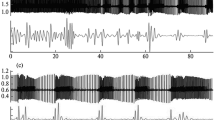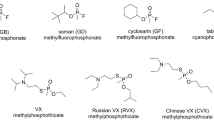Abstract
A short scientific review was presented of the author’s neuro-toxicological experimental and clinical investigations over a period of 24 years.
It presented various experiments with potassium cyanide, phosgenoxim, phosphororganic compounds (tabun, sarin, trichlorphon, dimethoate) and chlororganic compounds (DDT, hexachlorane etc.).
For example — absolutely lethal doses of potassium cyanide were administered to more than 1,000 animals of various species (worms, snails, frogs, mices, rats, rabbits, dogs): from worms to dogs these doses decreased progressively 200 times. The same doses were administered to more than three species of animals (dogs, rabbits, rats etc.) after previously separate or combined treatment with various neurotropics: a) with chemicals inducing greater excitability of the CNS (strychnine etc.) the poisoning became more acute and all animals died; b) in the cases of experimental catalepsy (caused by haloperidol etc.) or artificial hypothermy, there was a lengthening of life and sometimes even survival (protective effect) while all the controls died; c) there was the same protective effect of optimal doses of neurotropics, which caused profound sleep or light narcosis — e.g., acute cyanide poisoning (5–7 mg/kg) in dogs after chloralhydrate given per os (300–400 mg/kg) or in combination with chlorpromazine given intramuscularly (2–4 mg/kg); d) this effect was absent in the cases of light sleep or of deep narcosis. Proceeding from the experimental data which revealed the role of the initial functional state of the CNS in the course of intoxication, the CNS is proposed to be not only an “object” of toxic lesion and a source of pathological regulation, but also the main “subject” of the organism’s defensive-adaptive reaction to toxic agents. The most important is the signal or warning role as a conditioned reflexes in the CNS, which gives the possibility for the organism to take the best avoiding action to the intoxication. In this sense man demonstrates an active behaviour and an effort to change the intoxication sources in his environment. This is a new ecological concept in the understanding of neurotoxicology. On the basis of the experimental results a theory was formulated about the intoxication process conceived as a toxic chain reaction that is a confrontation between two opposing forces: toxic-damaging (due primarily to the poison) and defensive-adaptive (caused by the normal reactivity of the organism, especially of the CNS). The clinical picture of the poisoning is an outward expression of this contradictory chain process.
Access this chapter
Tax calculation will be finalised at checkout
Purchases are for personal use only
Similar content being viewed by others
Author information
Authors and Affiliations
Editor information
Editors and Affiliations
Rights and permissions
Copyright information
© 1982 Springer-Verlag
About this paper
Cite this paper
Mikhaïlov, S.H. (1982). Toxicology of the Central Nervous System — Pathogenetical Aspects. In: Chambers, C.M., Chambers, P.L. (eds) New Toxicology for Old. Archives of Toxicology, vol 5. Springer, Berlin, Heidelberg. https://doi.org/10.1007/978-3-642-68511-8_18
Download citation
DOI: https://doi.org/10.1007/978-3-642-68511-8_18
Publisher Name: Springer, Berlin, Heidelberg
Print ISBN: 978-3-540-11406-2
Online ISBN: 978-3-642-68511-8
eBook Packages: Springer Book Archive




